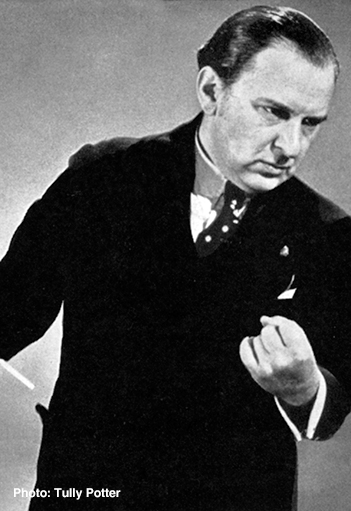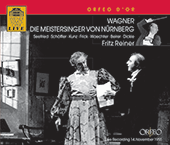Fritz Reiner
Fritz Reiner was born into a mercantile family, although his mother was a keen amateur musician and he himself began to study the piano when he was six, soon showing signs of musical gifts and a highly retentive memory. At the age of ten, he became a pupil at the Franz Liszt Academy in Budapest, where he was an active student, taking the solo part in piano concertos and playing percussion in the student orchestra. His teachers included Béla Bartók and Leo Weiner, who encouraged him to think of conducting as a future career. Despite his father’s preference for him to pursue law as a profession, Reiner became a répétiteur at the Budapest Comic Opera, making his conducting debut there when he was 19, with Bizet’s Carmen, in the time-honoured fashion of replacing a sick colleague. Later he said that this was ‘the hardest thing I ever did’. He was appointed as a staff conductor at the Ljubljana Opera House for the 1910–1911 season, where the first conductor was Václav Talich (like Reiner a great admirer of Arthur Nikisch); and in 1911 he secured a position at the Népopera in Budapest, a large-scale private enterprise separate from the Royal Hungarian Opera, whose performances were aimed at a widely-based popular audience. Here Reiner initially conducted operetta and later grand opera, including the first performance of Wagner’s Parsifal in Europe following the expiry of its copyright at the end of 1913.
This helped to advance his reputation and in the summer of 1914 Reiner was invited to conduct at the Saxon Court Opera (the Semper Opera House in Dresden) on a trial basis, following the death of Ernst von Schuch. Immediately after his first performance, of Rigoletto, he was offered a contract for a permanent position, working alongside the theatre’s two other conductors and conducting symphony concerts as well as operas. At Dresden, he formed a close relationship with Richard Strauss, conducting the first performance of his opera Die Frau ohne Schatten after its Viennese première of 1919. Because of the city’s proximity to Berlin and Leipzig, he was also able to attend many performances conducted by Nikisch, whom he observed closely. However Reiner gradually became restless in Dresden, aspiring to, but not being offered, the post of chief conductor; and in November 1921 he resigned his position there. After conducting engagements in Italy and Spain he accepted without hesitation an offer from the Cincinnati Symphony Orchestra to become its chief conductor, with effect from the start of the 1922–1923 season.
Reiner’s career in the USA, where he lived for the rest of his life (he took American citizenship in 1928), was based upon the long-term musical directorship of three major symphony orchestras: the Cincinnati Symphony Orchestra, from 1922 to 1931; the Pittsburgh Symphony Orchestra, from 1938 to 1948; and last but certainly by no means least, the Chicago Symphony Orchestra, from 1953 to 1963. In each instance he raised the playing standards of these orchestras to a very high level, and with the last two made a considerable number of commercial recordings. Between 1948 and 1953 he was on the conducting staff of the Metropolitan Opera House, New York, where he led the first American performances of Stravinsky’s The Rake’s Progress. In addition to these permanent appointments, Reiner was active as a guest conductor and as a teacher. Between the two world wars he conducted opera in both Europe and South America; a recording of his Tristan und Isolde at Covent Garden in 1936 has been preserved, and he also appeared at the Vienna State Opera, conducting Die Meistersinger von Nürnberg in 1955. Between 1931 and 1941 he taught conducting as the head of the opera and orchestral departments at the Curtis Institute in Philadelphia, where his pupils included Leonard Bernstein, Lukas Foss and Walter Hendl. At Curtis, Reiner encouraged his students to sing and conduct the recitatives from Mozart’s operas in order to develop a sense of vocal rhythm. In the autumn of 1959 he suffered a massive heart attack which forced him to cancel nearly all of his performances with the Chicago Symphony Orchestra during the 1959–1960 season. When he ultimately returned to the podium, he was noticeably thinner and weaker and had to conduct from a sitting position. No longer a well man, he stepped down as chief conductor of the Chicago Symphony Orchestra at the end of the 1962–1963 season, to be succeeded by Jean Martinon.
Apart from his superb musicianship, Reiner was famous as a conductor for two things: his spare conducting style and his menacing temperament. He learnt the value of economical gestures from his idol Nikisch, and was reputed to have commented about his conducting style, ‘They say I have a small beat, but it is a good one.’ The purpose of these tiny gestures was to focus the attention of his orchestral players upon himself alone. He used a long baton, and would indicate the phrasing which he sought with small movements made within the overall delineation of the beat. His players were left in no doubt as to his intentions: he possessed a virtuoso stock of small but meaningful physical signals, such as puffing out his cheeks to indicate an entry for the wind players, and all the time he would be looking remorselessly at the individual members of the orchestra with the most penetrating gaze. The stories about his legendary temper are legion: one player commented that ‘…any day he failed to lose his temper was a day when he was too sick to conduct.’ At the same time he had a rather dark sense of humour. His biographer Philip Hart tells a story of the day of his first rehearsal as chief conductor with the Chicago Symphony Orchestra: a violist introduced himself with the words ‘It’s a pleasure, Dr Reiner’, to which Reiner ominously replied, ‘We’ll see.’
The key characteristic of Reiner’s performances was their extraordinary level of technical accuracy, manifested in the precise observation of tempi, dynamics and phrasing. His preparation was exhaustive and complete, and the exacting standards that he held for himself were also applied to the musicians of the orchestras which he commanded. With his mastery of architectural structure and his precise sense of rhythm, Reiner was able to create performances that were expertly structured, superbly detailed, immaculately executed and, overall, performed with an appropriate sense of style. Although he made numerous recordings with the Pittsburgh Symphony Orchestra during the 1940s, many of which exhibit these characteristics, their full manifestation on disc was only realised with the advent of RCA’s ‘Living Stereo’ engineering, which was used for his recordings with the Chicago Symphony Orchestra. The timing of his appointment to the Chicago post coincided exactly with RCA’s plans for the development of stereophonic sound, which involved the company recording this orchestra in stereo from 1954 onwards. Reiner’s insistence on intensive preparation, the virtuosity of the Chicago Symphony Orchestra, and the superb sound achieved by RCA producers Richard Mohr and John Pfeiffer resulted in some of the finest commercial recordings of classical music ever made. Virtually all of these recordings can be recommended without hesitation, as can the more limited number of recordings for other labels and from live performances that have appeared commercially. Reiner’s achievement was aptly summed up by Harold Schoenberg, who wrote of him: ‘As a musical intellect, as an incomparable musician, as the possessor of an ear virtually unparalleled in his field, Fritz Reiner held a unique spot in twentieth-century musical life and thought.’
© Naxos Rights International Ltd. — David Patmore (A–Z of Conductors, Naxos 8.558087–90).


















